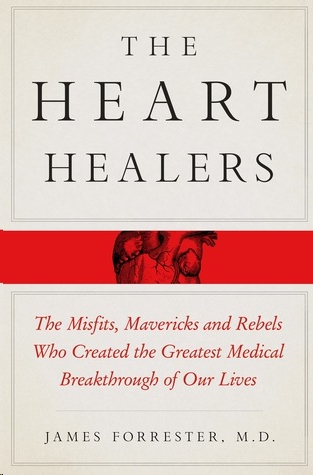
The Heart Healers
The Misfits, Mavericks, and Rebels Who Created the Greatest Medical Breakthrough of Our Lives
بدبختیها، ماوریکس ها، و شورشیهایی که بزرگترین تحول پزشکی زندگی ما را ایجاد کردند
کتاب های مرتبط
- اطلاعات
- نقد و بررسی
- دیدگاه کاربران
نقد و بررسی

Starred review from July 6, 2015
Forrester, a cardiologist and professor of medicine, has fashioned a stunning survey of cardiology’s “Golden Age” and the “misfits” who made it so. These pioneers discovered the means to fix—and even replace—damaged hearts, restore life after sudden death, effectively treat heart attacks as they are happening, and turn “the scourge of the 20th century,” coronary artery disease (CAD), “into a preventable disease.” He begins with the first cardiac surgeon, Dwight Harken, who saved a WWII soldier wounded with shrapnel in his heart, and Charles Bailey, who perfected the surgery to repair failing hearts with mitral valve stenosis. Forrester’s impressive roster also includes the outspoken Mason Sones, who developed the coronary angiogram; Argentine surgeon Rene Favaloro, an idealist who introduced coronary artery bypass surgery; and Japanese biochemist Akira Endo, who discovered statins, “the wonder drug for treatment of CAD.” Forrester also tells his own touching story of treating a 12-year-old El Salvadoran girl: “a frail little girl standing alone in a joyless room, a foreign land, trusting her life to strangers she could barely understand.” It’s a book of marvels, and Forrester eloquently argues that “cardiology’s Golden Age deserves a place on the short list of the last half century’s scientific wonders.”

June 15, 2015
A scientific memoir/biography of the significant achievements of heart doctors through the years. Forrester (Medicine/UCLA) is the former chief of the division of cardiology at Cedars-Sinai and a recipient of a lifetime achievement award from the American College of Cardiology, so he is more than qualified to tell this story. For most of his subsequent career as director of one of the National Heart, Lung, and Blood Institute's Centers for Research in Ischemic Heart Disease Center, he has been directly involved in a series of astonishing medical advances. In the early 1990s, he led a team that developed coronary angioscopy, a medical technique for visualizing the interiors of coronary arteries by inserting a flexible catheter directly into the artery. In the 1960s, at the start of his career, the treatment of patients experiencing a heart attack was primitive as compared to today. "More lives were being lost in a single year than in all of World War II," writes the author. Today, heart disease is surgically treatable and in many instances preventable with the help of diet, exercise, and cholesterol-reducing drugs. Open-heart surgery, the first of the advances he chronicles in the readable, accessible narrative, occurred in 1944. Dwight Harken, at the time a daring battlefield surgeon, performed the first successful open-heart surgery to remove shrapnel. The adaptation of the operation in peacetime involved improved diagnostic tools, including the development of a heart-lung machine. With the new tools and methods, the mortality rate for congenital heart surgery has decreased from 50 percent to 2 percent. Another major milestone, writes Forrester, was the introduction of "coronary artery bypass graft surgery" in 1967. It dramatically reduced angina (pain indicative of a potential heart attack), but as one of his students discovered, it was the suddenness of an occlusion, not gradual blockage, that caused a heart attack. Throughout the book, the author achieves a nice balance of memoir and scientific history. A heartwarming account of risk-taking, iconoclastic doctors who achieved extraordinary cardiovascular breakthroughs and of the patients who trusted them.
COPYRIGHT(2015) Kirkus Reviews, ALL RIGHTS RESERVED.

Starred review from July 1, 2015
Forrester, a renowned heart surgeon who served as head of one of the National Heart, Lung, and Blood Institute's Centers for Research in Ischemic Heart Disease, offers a colorful account of the development of cardiac surgery. After interviews with several pioneers in the field, he uses notes and case histories to illustrate the bold experiments that led to the miraculous treatments available to patients with heart disease today. In 1895, Ludwig Rehn, a German doctor, repaired the heart of a young man injured in a knife fight--the first successful cardiac surgery. In 1929, Werner Forssman inserted a cardiac catheter into his own heart. These men made it possible for others, such as Dwight Harken, who repaired the hearts of injured soldiers during the London Blitz, and Charles Bailey, who repaired a heart valve damaged by rheumatic fever, to develop the field of cardiac surgery. VERDICT Forrester brings history to life and explains complex procedures for lay readers in this excellent book for readers interested in medical history and those who want to understand modern medical procedures.--Barbara Bibel, formerly Oakland P.L.
Copyright 2015 Library Journal, LLC Used with permission.

September 1, 2015
Failure plays a big role in scientific discovery and medical advances. Cardiologist Forrester takes us on a trip through time and technology as he mingles biography and medical history in this homage to the physicians and patients who contributed to the advancement of cardiovascular treatments since WWII. Many of the doctors described here possess peculiar personalities. They tend to be unconcerned with criticism, nonconformists, risk-takers, and quite stubborn. Sometimes their errors and misjudgments cost patients their lives. These physician-scientists made key contributions to the field of cardiology, including the heart-lung machine, cardiac resuscitation, valve replacements, the invention of pacemakers and defibrillators, clot-dissolving therapy, coronary artery bypass graft surgery, balloon angioplasty and stents, heart transplantation, and statin drugs that lower cholesterol levels. Forrester concludes his unusual focus on rescuing hearts that are too good to die by looking to the future. He reports on research that uses cardiac stem cells to treat heart failure, the engineering of wireless pacemakers, administering a single injection of a modified gene to permanently reduce LDL cholesterol, and bioprinting tissues. Fascinating and universally relevant.(Reprinted with permission of Booklist, copyright 2015, American Library Association.)

























دیدگاه کاربران